Michigan vegetable crop report – June 7, 2023
Harvests of early field-planted crops are right around the corner for some growers and starting now for others. Continued irrigation is a must.
Weather
Watch Jeff Andresen’s weather update.
The forecast calls for:
- Continued fair and dry through Friday, June 9.
- Scattered showers and thundershowers possible Saturday and Sunday. Showers possible early next week.
- High temperatures gradually warming from the low and mid-70s Wednesday, June 7, to the upper 70s and low 80s by Saturday. Low temperatures in the 40s to the low 50s through Friday warming to the 50s this weekend.
- Potential evapotranspiration rates will continue at elevated levels through next week (approximately 0.20 inches per day).
- Medium range guidance calls for near normal mean temperatures and precipitation totals next week, but a return to warmer and drier than normal weather again by the third week in June.
Check out the asparagus section below and the Michigan State University Extension article, "Dry forecast: How will that impact weed control?" about the impacts of this weather on herbicides. See below for impacts on fertility.
Nitrogen fertilizer and dry weather
With dry soils and very little rain in the extended forecast, volatilization losses from surface-applied urea fertilizers is a concern. Here are a few notes to protect your investment:
- Urea needs to get into the soil to avoid significant volatilization losses. Tillage usually does the job well if incorporated to at least a 3-inch depth (and into moisture). When broadcasting without tillage, 0.3-0.5 inches of rain or irrigation are generally needed.
- If irrigation isn’t available (and rain isn’t imminent), coating urea with a urease inhibitor like NBPT (Agrotain, N-Dure and other trade names) is a must to reduce volatilization risk. Keep in mind the inhibitor will break down over time. It is generally only effective for seven to 14 days. When the extended forecast is dry, delaying your application can be a good idea to increase the chance of catching rain within that timeframe.
- Polymer coated ureas (e.g., ESN and others) will also protect against volatilization losses when surface applied, potentially for a longer period than a urease inhibitor, due to physical protection and limited availability without moisture. However, they will also release nitrogen (N) slower than urea once moisture arrives (with pros and cons).
- You may also consider other N sources with lower risk of ammonia volatilization than urea. Nitrate-containing granular N fertilizers have low risk. Liquid urea ammonium nitrate (UAN) has reduced risk due to lower urea content but is still susceptible to losses when surface applied. Consider including a urease inhibitor or injecting into the soil (as equipment allows).
- Finally, remember that any source of available N (and other nutrients) must get into the soil and dissolve in soil moisture to be available to your crop. When moisture limits crop growth it will also limit nutrient demand. Your goal is to make sure as much of the N you apply as possible actually makes it into the soil (rather than being lost to the atmosphere) to be available when the crop needs it.
Weed of the week
Common lambsquarters (Chenopodium album) is an early-emerging summer annual weed in the Amaranth family. Lambsquarters occupies the same botanical family as beets, spinach, and swiss chard, as well as the same genus as quinoa. This weed is readily identified by its toothed, triangular leaves, white grainy texture on younger leaves, and densely-packed flower clusters. It is highly competitive and tolerant to dry/saline soil conditions. Like marestail or pigweed species, lambsquarters is extremely prolific with an average adult plant producing 70,000 seeds or more, making seed bank management a priority when dealing with heavy lambsquarters pressure in your fields.
Many pre-emergent, post-emergent, and dual action (pre- and post activity) herbicides can be very effective in controlling lambsquarters when they are still small. Find more information in this table containing different herbicides for lambsquarters management. For non-chemical control, cultivation works best when targeting lambsquarters early on at the “white thread” stage when plants are most vulnerable. Excluding light during cultivation or tillage has been shown to reduce lambsquarters emergence as light is a common trigger for weed seeds to cycle out of dormancy.
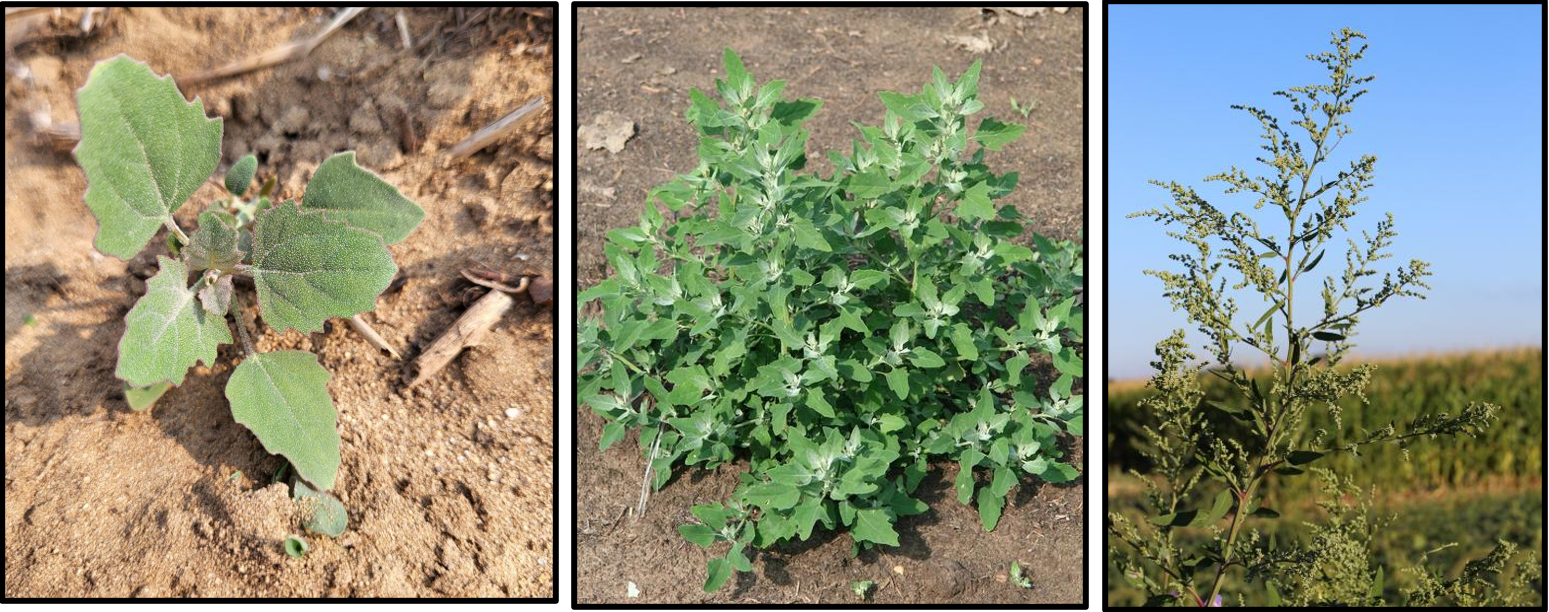
2023 MSU Extension Southeast Michigan Farmer Survey
MSU Extension is pleased to announce our 2023 Southeast Michigan Farmer Needs Assessment Survey. This survey will gather information about your farm and your potential interest in learning more about various farm-related topics. The information gathered will inform future programs and educational opportunities offered by MSU Extension educators for agricultural producers in southeast Michigan. This survey will take approximately 10 minutes to complete and is accessible at the link below:
Take the 2023 MSU Extension Southeast Michigan Farmer Needs Assessment Survey!
Feel free to share the survey link with other growers. We welcome any participation in the survey in order to help Michigan State University Extension better serve its communities.
Crop updates
Asparagus
Our crazy weather is raising a lot of questions, key amongst them being: Will postharvest herbicides work? For maximum activity, preemergence herbicides need at least a half-inch rainfall within seven days of application, though helpful amounts could persist through 14 days.
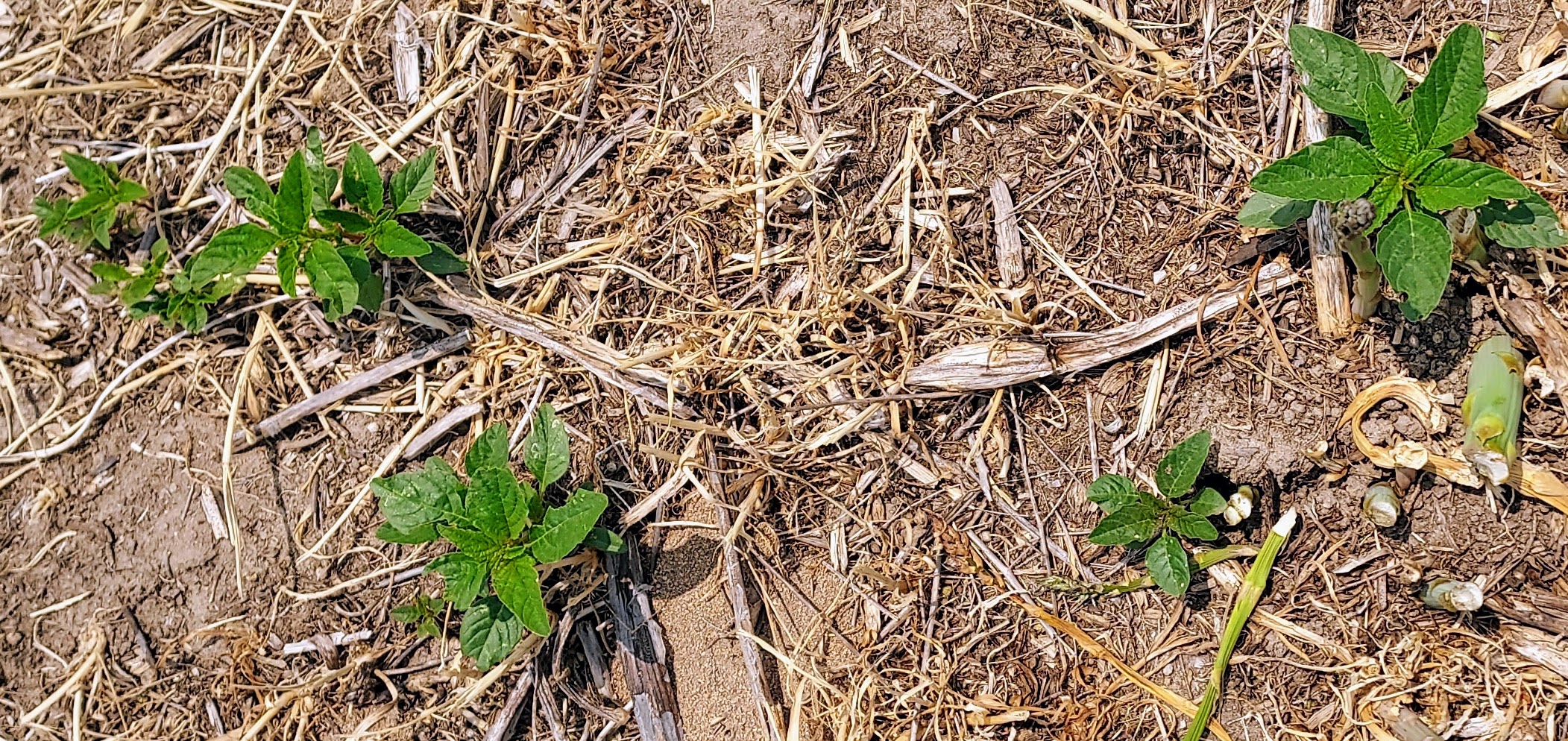
As time moves on, so will the forces that degrade herbicides. Herbicides typically are more persistent in dry soil as the microbes that degrade them are less active. On the other hand, preemergence herbicides that remain on the soil surface are more likely to get degraded by volatilization (soil surface temperatures can be much higher than air temperatures) or photodegradation (degradation by sunlight). Some preemergence herbicides are more prone to photodegradation and volatility loss (Prowl, Treflan etc.) than others (Chateau, Lorox, Tricor, Spartan, Karmex etc.). Herbicides that bind tightly to soil colloids may provide more consistent control during dry years. Group 3 herbicides (trifluralin, Treflan; pendimethalin, Prowl H2O) require more soil moisture than others due to their high affinity for soils. Read more about herbicide activation and rainfall. Read more about general factors that cause herbicides to degrade.
Even with dry conditions, residual herbicides are valuable and important for weed management. Typically, by late May into June, growers see the “red edge” as small pigweed seedlings emerge, which partially drains the seedbank (and gives pickers headaches). Given the lack of rainfall until now, it is possible there are more pigweed seeds lying in wait to germinate later when we do get rain. Put another way, we may have what is the opposite of a stale seedbed. Therefore, it is important to apply preemergence herbicides at layby so when rainfall occurs, they get activated and inhibit weed germination.
The efficacy of postemergence herbicides can also be reduced with hot and dry weather. Under these conditions weed growth slows down, leaves produce more wax and cell walls harden, all of which can reduce herbicide uptake and translocation. Also, with hot, dry conditions, spray droplets evaporate faster, leading to faster drying times and reduced absorption. Systemic herbicides such as Roundup, Clarity, 2,4-D, Stinger, Quinclorac, SelectMax, Poast and Fusilade are more prone to issues than contact type products such as Aim and Gramoxone. Performance is optimal when weeds are growing at air temperatures of 70-85 degrees Fahrenheit with good soil moisture.
Take home messages:
- Group 3 herbicides (Treflan, Prowl H2O) are more prone to volatilization, photodegradation and binding tightly to soil colloids.
- Try to target herbicide applications when rainfall is forecast within two weeks.
- Use adjuvants and surfactants to facilitate POST herbicide absorption by enhancing spray droplet retention on the leaf surface, dissolving waxy cuticles, and holding spray droplets on the leaf for longer duration.
- Use the highest labeled rate possible that is safe for the crop.
- Increase spray volume to ensure optimal coverage for POST herbicides.
- Depending upon the product, use nozzles that produce coarse or extra coarse droplets, which dry slower than mediums and fines.
- Spray earlier in the day when weeds are more hydrated and biologically active.
Drift can also be a concern when fields get shutdown at different times. Here are a few tips from a presentation Jason Deveau of the Ontario Ministry of Agriculture, Food and Rural Affairs (OMAFRA) gave three years ago:
- Keep booms low and go slow.
- Use the coarsest nozzle possible given the product you need to apply.
- A little bit of wind is good: Inversions tend to form after sunset and dissipate after sunrise once a light breeze picks up.
Note there are two kinds of drift: particle drift and vapor drift. Particle drift is when droplets are carried away by the wind; it’s what we are most used to and occurs over feet. It creates patterns that make sense: injury on the side of the field downwind from the application site. Cooler and/or windy conditions favor particle drift (slow drying times and/or wind to pick up the product). Vapor drift happens when volatile herbicides are picked up and can happen over miles. Hot conditions that evaporate the water in the droplet favor this type of drift. 2,4-D and dicamba are herbicides that can volatilize. There is a formulation of 2,4-D called Embed Extra that may help to some degree, and using a bit more water volume and coarse droplets can also help.
One piece of good news: Asparagus does not have a high water demand during harvest. So, while the top of the soil may be dry from evaporation, there could be moisture down below. One grower let us dig down into a field this week (Thank you!). While the top was bone dry, there was moisture from 6-24 inches. So, at least at this site, there is soil moisture available for plants to take up as fern emerges. Water demand increases as fern develops, so hopefully it will rain.
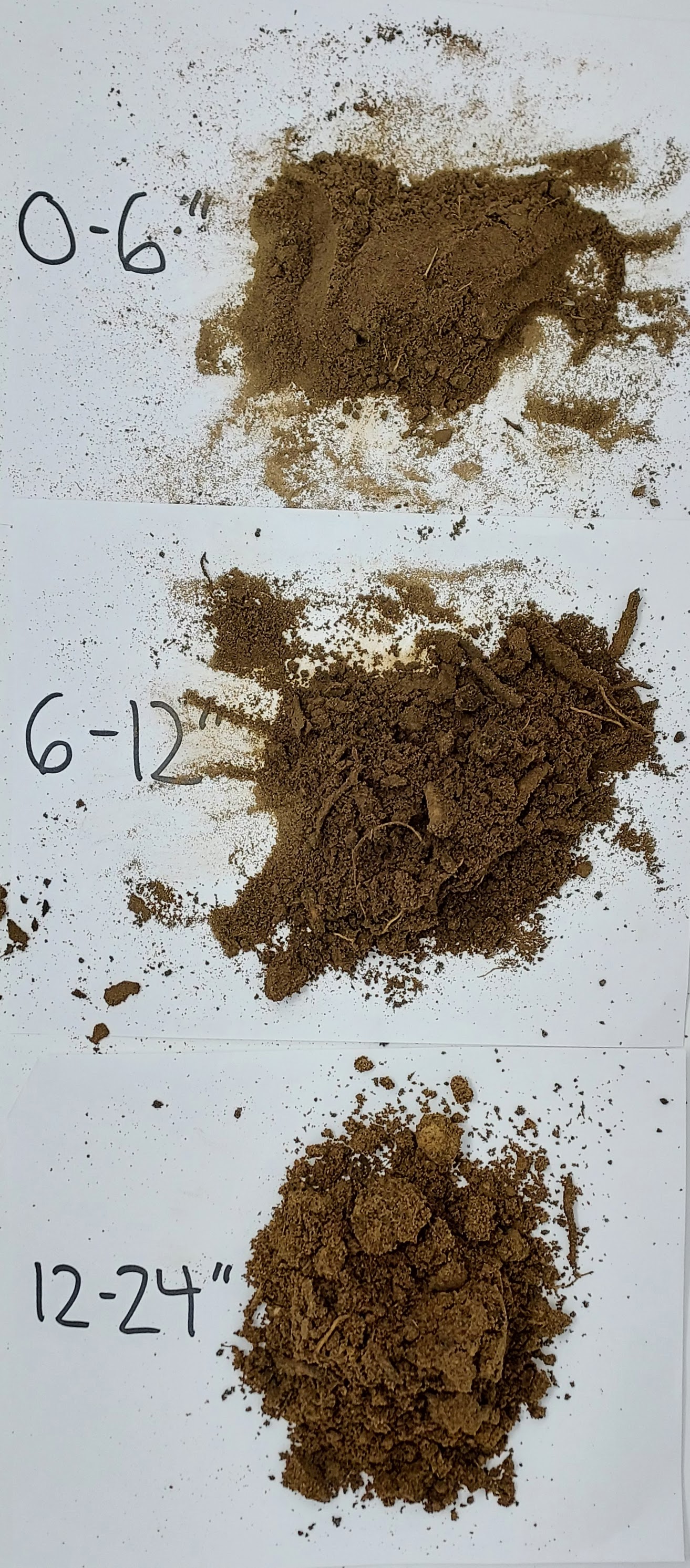
This raises the question: Why was quality better in irrigated fields during this heat? Thankfully, Zack Hayden has a trial at the West Central Michigan Research and Extension Center that should help answer this question.
Carrots/celery
Carrots can benefit from stale-seedbedding to limit weed competition as they slowly emerge. This can be accomplished with flamers, shallow tillage tools and tarps. With the current weather conditions, irrigation may be required to get the weeds to germinate more quickly. Otherwise, they will lay dormant and emerge with your crop.
Aster leafhopper numbers are beginning to pick up. Keep an eye out for texts later this week to see if infectivity picks up. None of the tested leafhoppers had aster yellows as of last week.
Cole crops and leafy greens
Early broccoli is getting close to harvest on some farms. Field greens are starting to be harvested as hoophouses transition to more dedicated fruiting vegetables and cucurbits.
Nearly all insect pests of brassicas can be found right now. Bt can be effective when caterpillars are small and conserves beneficials that help control other pests. Read more about use of Bt here. Other insecticides for use on caterpillars that also have good efficacy on flea beetles include pyrethroids/pyrethrins like Pyganic, Mustang Maxx, Warrior II and Brigade, but also the diamides like Coragen, Harvanta and Exirel. Good ol’ carbaryl can also be used. The pyrethroids and organophosphates can also cause flare ups or resurging populations of aphids and thrips by killing off beneficial insects.
Both aphids and thrips can be managed with Movento, Radiant or Exirel, which have a lower impact on beneficial insects than other broad-spectrum insecticides. If aphids are the only problem, mouth paralyzers like Beleaf, Fulfill and Sefina are a good choice to protect other insects. For thrips alone, Entrust is an organic option for suppression.
The spring peak of cabbage maggot is winding down. Eggs were still being laid but mostly maggots were present in brassica root crop fields MSU Extension is monitoring. Flies that develop from these spring maggots have been or will start emerging to create the first summer flight, which can cause issues in root crops. To keep tabs on it, check out the new, online cabbage maggot predictor tool. In leafy brassicas, the ghost of spring damage was present as wilted/stunted/dead plants at one location, but those that survived were growing and doing well.
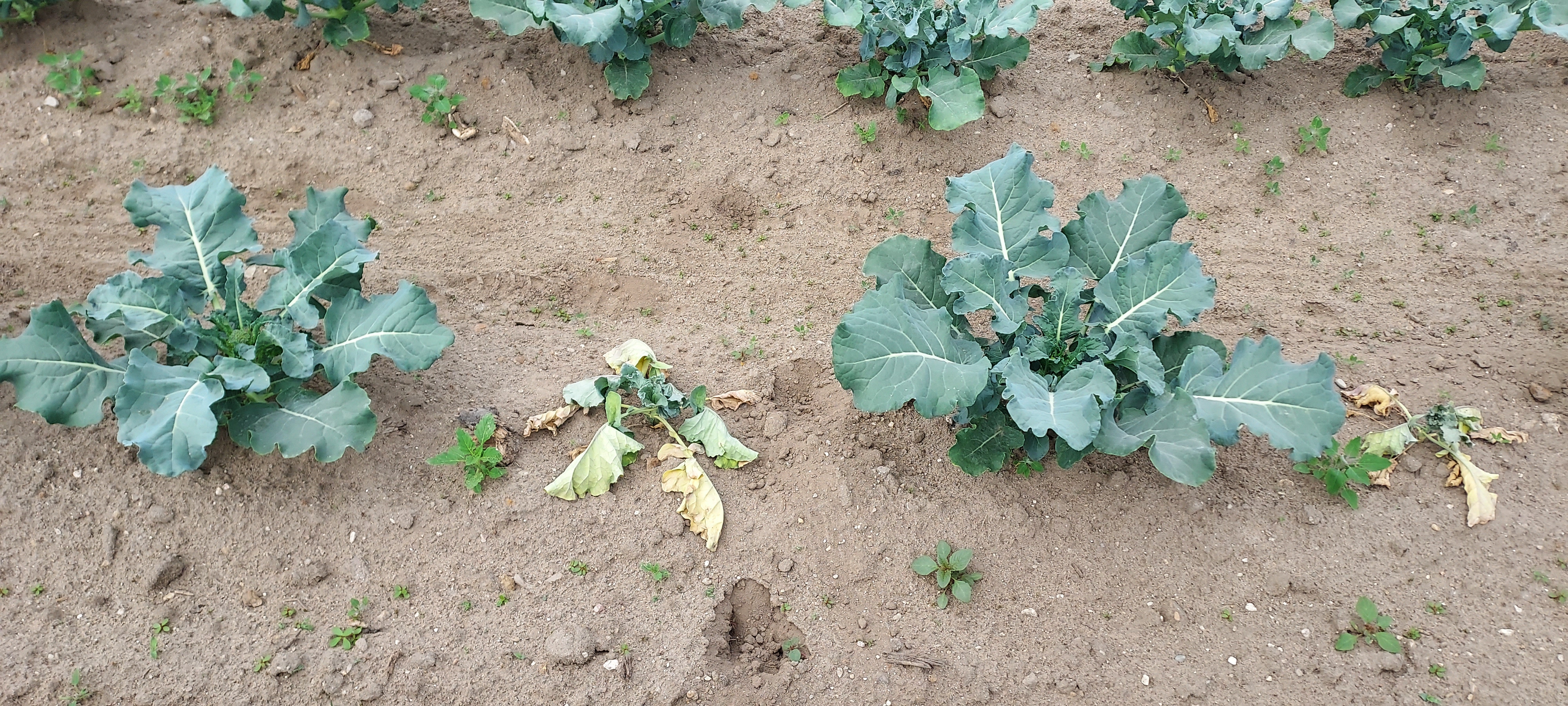
One farm has experimented with floating row cover this year in radishes to prevent maggot issues, using a machine that spools out/spools up the cloth. Some of the radishes outside the cover were wormy. Underneath, there was good quality.
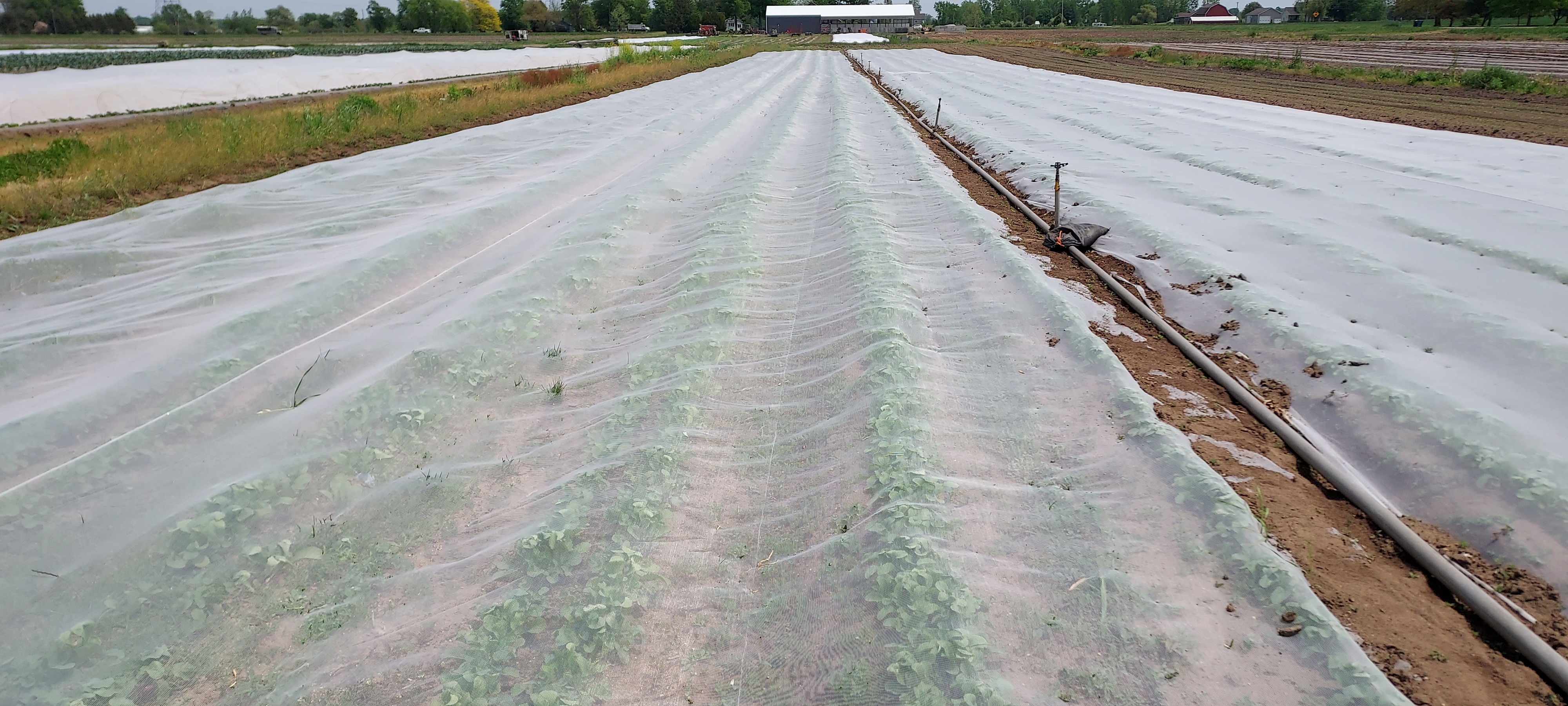
For longer crops like broccoli or kale, get in there for weed management periodically. Smaller-scale growers can try engineering individual-row low tunnels to hold fabric up to harvest and weed much like a caterpillar tunnel.
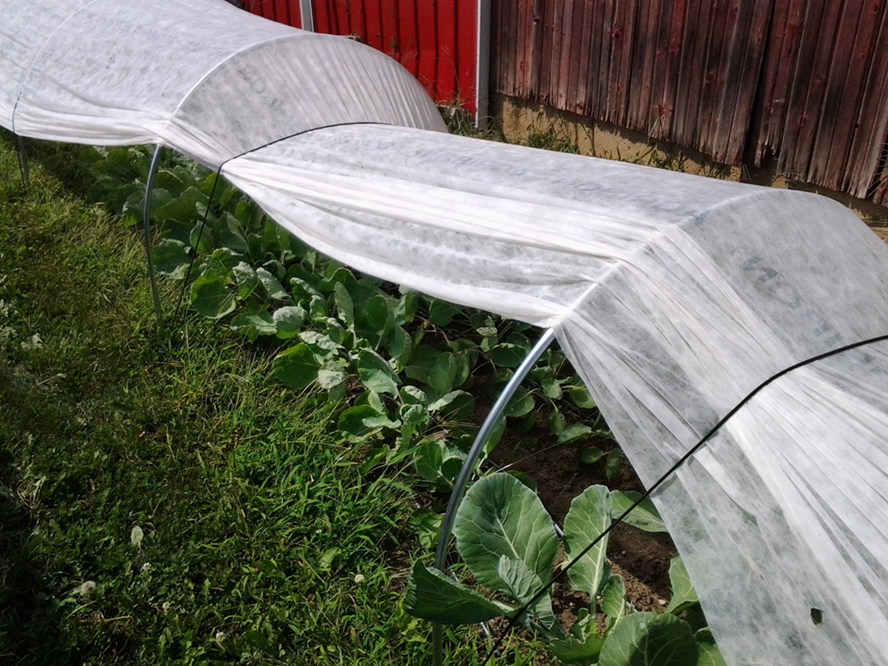
Cucurbits/pickles
Cucurbit planting continues across lower Michigan. Pumpkins and hard squash plantings are starting up this week for fall markets. Early cucumber plantings are at first flower this week, and some farms may be harvesting zucchini soon. The early summer squash plants in southwest Michigan jumped with the heat last week.
Weed control and crop safety are always questions with cucurbits. Check out this table by Sushila Chaudhari, which lists the options, their strengths and key notes. Also, check out this helpful article on weed control from Minnesota.
Fruiting vegetables
Transplanting of tomatoes and peppers into plastic mulch is ongoing. The first trellis strings were going on the stakes this week in southwest Michigan, as tomatoes jumped in size with the heat. Non-chemical weed control between rows in plasticulture systems is generally achieved through regular, shallow cultivation or applying organic mulches like straw. Previous research by Alyssa Tarrant and Zachary Hayden at MSU has explored the tradeoffs and the variables that influence success when using living mulches between plastic rows. For chemical control, preemergent and post-emergent herbicide options are outlined in the articles ”Recommendations for Under Plastic Mulch Weed Control” and “Weed Management in Tomatoes, Peppers and Eggplant” from Rutgers University.
Transplanting on hot black plastic is a tough condition for plants to grow through. Their stems can girdle from the heat. The most common method to reduce these stressors is to water transplants really well in the trays and get the beds fully wetted before planting so that some evaporative cooling occurs through the holes and plants have plenty of moisture to replenish what they are respiring. Then, center the plants as best as possible so that they are not touching or laying on the plastic. Leggy tomatoes can make this tough! Some growers combine this with temporary overhead irrigation. Others will try to back-fill the holes to create a seal around the plants. Be aware that some between-row herbicide treatments can potentially damage plants. One further technique we have witnessed is to spray kaolin clay (Surround) onto the beds to create a temporary white surface to reflect more sun.
Onions
Onion thrips were above threshold in some transplanted onions this week, and it will be good to check direct sown ones as early weed sprays wrap up. Keep in mind that once plants start to bulb, which will happen soon in some transplanted varieties, Movento does not work as well (bulbing typically happens around the seven to eight leaf stage).
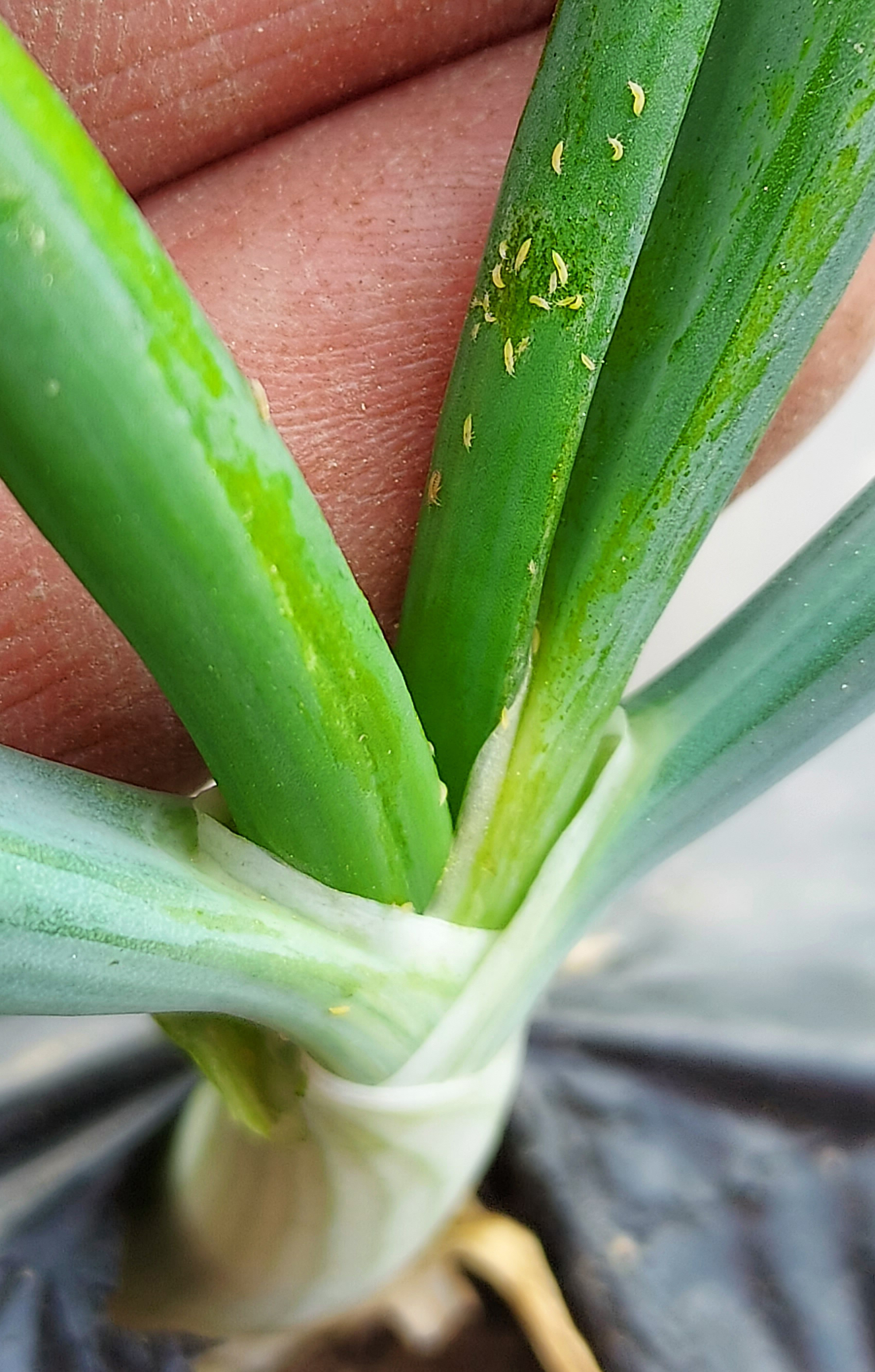
Below is a repeat from last week that bears repeating. Spots and blights on the leaves can get in the way of good onion growth. In Michigan and other eastern production regions, producers wage a yearly battle to protect onions from various foliar diseases. Purple blotch used to be a common disease of onion leaves in the northeast U.S. but Stemphylium leaf blight has now become the most formidable opponent for many onion producers. Stemphylium leaf blight is caused by a fungal pathogen of the same name (Stemphylium vesicarium).
Early symptoms of Stemphylium leaf blight can be difficult to diagnose. Tip burn may be associated with herbicide damage but can also be a first symptom of disease. The brown spots of Stemphylium leaf blight are small at first but increase in size, extending down the leaf. These elongated lesions can appear similar to symptoms of bacterial stalk and leaf blight. An accurate diagnosis can be obtained by sending plant samples with symptoms to a university diagnostic lab. In healthy onions, the oldest onion leaves die first. However, premature leaf death resulting in a mid-season loss of green leaf tissue is typical of Stemphylium leaf blight. Without healthy foliage, bulb size is reduced and so is total yield.
Many of the fungicides that were historically used to manage purple blotch do not adequately protect against Stemphylium leaf blight. Field research from Michigan State University has shown that the Stemphylium leaf blight pathogen is resistant to fungicides classified as strobilurins such as azoxystrobin, picoxystrobin, pyraclostrobin, and trifloxystrobin. On the other hand, Omega SC, Luna Tranquility SC, Miravis Prime SC, Tilt SL and Luna Experience SC effectively limit Stemphylium leaf blight. Our research has also shown that fungicide programs to protect the onion’s foliage from Stemphylium leaf blight should begin when plant are young (by the five- to seven-leaf stage) and include highly effective products at the front end of the season to prevent the pathogen from becoming too well established. Once Stemphylium leaf blight is well established, it becomes especially difficult to limit disease progression. Protecting the onion leaves early in the season helps to ensure that the plants have a fighting chance to reach maturity and achieve their full yield potential.
Choosing an effective fungicide program is critical and in combination with initiating the spray in a timely manner as described above can ensure successful management of an otherwise highly destructive pathogen. Field research from Michigan State University tested two fungicide programs with sprays applied every seven days (Table 1). Each program effectively limited disease but Program #2 is less reliant on fungicides that have a similar mode of action.
|
Table 1. Two fungicide programs applied at seven-day intervals for Stemphylium leaf blight control by MSU in field trials. |
|||
|
Program 1 |
Program 2 |
||
|
App#. Product |
FRAC |
App#. Product |
FRAC |
|
1. Luna Tranquility |
7/9 |
1. Bravo WS |
M05 |
|
2. Tilt SC + Bravo WS |
3/M05 |
2. Tilt SC |
3 |
|
3. Omega 500F |
29 |
3. Luna Tranquility |
7/9 |
|
4. Luna Tranquility |
7/9 |
4. Bravo WS |
M05 |
|
5. Tilt SC + Bravo WS |
3/M05 |
5. Tilt SC |
3 |
|
6. Miravis Prime |
7/12 |
6. Miravis Prime |
7/12 |
|
7. Omega 500F |
29 |
7. Bravo WS |
M05 |
|
8. Aprovia Top |
7 |
8. Bravo WS |
M05 |
|
9. Miravis Prime |
7/12 |
9. Luna Tranquility |
7/9 |
|
10. Luna Tranquility |
7/9 |
10. Bravo WS |
M05 |
The Stemphylium leaf blight pathogen is considered high risk to develop resistance to some of the active ingredients in commonly used fungicide products. It is essential to rotate among fungicides with different FRAC codes. Also, it is important to avoid high disease pressure as this exposes a greater portion of the pathogen population to the fungicides and increase the likelihood for resistance to develop. The table below (Table 2) can be used as a guide for producers putting together their programs.
|
Table 2. Fungicides labeled for use on onion included in MSU field studies. |
|||
|
Product |
Active ingredient |
FRAC |
Number of applications allowed by the label |
|
Tilt |
propiconazole |
3 |
2 to 4 (solo); 4 to 8 (in tank mixes) |
|
Aprovia Top |
difenoconazole/benzovindiflupyr |
3/7 |
4 |
|
Luna Tranquility |
fluopyram/pyrimethanil |
7/9 |
2 to 3 |
|
Miravis Prime |
pydiflumetofen/fludioxonil |
7/12 |
3 |
|
Omega SC |
fluazinam |
29 |
3 to 6 |
|
Bravo WS |
chlorothalonil |
M05 |
6 |
*The FRAC code is an alphanumeric code assigned by the Fungicide Resistance Action Committee and is based on the mode of action of the active ingredient.
** The number of applications allowed by the label may vary depending on the rate applied. Remember that the pesticide label is the legal document on pesticide use. Read the label and follow all instructions closely.
When to spray Movento for onion thrips? It is a balancing act. On the one hand, Movento is most effective on immature onion thrips and its systemic action best carries it to the new growth prior to bulbing. This means it is important to not wait too long. On the other hand, applying it too early can mean extra applications of other products; it means the “momentum of Movento” won’t carry control that far into the season. Brian Nault of Cornell University shared some research based, Movento “thrips tips” at the 2022 GLEXPO:
- Make sure to use a penetrating surfactant.
- Two applications are better than one.
- Waiting until thrips reached populations of one per leaf gave control equivalent to a lower threshold, of 0.1 per leaf.
One more thrips tip: Exirel provided control equal to or better than Radiant in one New York trial, and was recommended as a replacement for the Radiant slot if Radiant is not pulling its weight like it used to. In an ideal world, scouting and thresholds can be used to time sprays. Keep an eye out for 2023 onion thrips guidelines from Cornell, which should be available soon.
Sweet corn
Succession plantings continue. Sweet corn is progressing well through the vegetative stages where there is adequate irrigation.
Strawberries
Both plasticulture and matted row berries are being harvested now.
Events
- June 8, 7–8 a.m., Field Crops Virtual Breakfast: Q & A "Hot Topics"
- June 12, 5:30-7 p.m., Monday Night Southwest Michigan Fruit IPM Meeting
- June 15, 7–8 a.m., Field Crops Virtual Breakfast: White Mold Management In Soybean
- June 19, 5:30-7 p.m., Monday Night Southwest Michigan Fruit IPM Meeting
- June 26, 5:30-7 p.m., Monday Night Southwest Michigan Fruit IPM Meeting
- June 28, 9:30 a.m.-3 p.m., MSU Weed Tour 2023
- June 29, 7–8 a.m., Field Crops Virtual Breakfast: Cercospora Leaf Spot Management In Sugar Beets
- July 6, 7–8 a.m., Field Crops Virtual Breakfast: Strategies For Efficient Irrigation Water Use
- July 13, 7–8 a.m., Field Crops Virtual Breakfast: Cover Crops After Wheat
- July 20, 7–8 a.m., Field Crops Virtual Breakfast: Tar Spot
- July 20, 9 a.m. - 1:30 p.m., In-Field and Edge-of-Field Conservation Practice Field Day
- July 27, 7–8 a.m., Field Crops Virtual Breakfast: Bugs And More Bugs!
- August 3, 7–8 a.m., Field Crops Virtual Breakfast: Farm & Truck Vehicle Regulations And Safety
- August 3, 8 a.m. - 4 p.m., 2023 Montcalm County Field Day
- August 10, 7–8 a.m., Field Crops Virtual Breakfast: How To Get The Best Out Of Your Drainage System
- August 17, 7–8 a.m., Field Crops Virtual Breakfast: "Hot Topic" Q & A Session
- August 24, 7–8 a.m., Field Crops Virtual Breakfast: Timing The Last Irrigation Application
- August 31, 7–8 a.m., Field Crops Virtual Breakfast: Setting The Stage For Record Breaking Wheat Yields
- September 7, 7–8 a.m., Field Crops Virtual Breakfast: Marketing Your Grain Crops
- September 14, 7–8 a.m., Field Crops Virtual Breakfast: Monitoring Nematode Resistance In Soybeans
- September 21, 7–8 a.m., Field Crops Virtual Breakfast: Fall Weed Control
This work is supported by the Crop Protection and Pest Management Program [grant no 2021-70006-35450] from the USDA National Institute of Food and Agriculture. Any opinions, findings, conclusions, or recommendations expressed in this publication are those of the author(s) and do not necessarily reflect the view of the U.S. Department of Agriculture.



 Print
Print Email
Email

